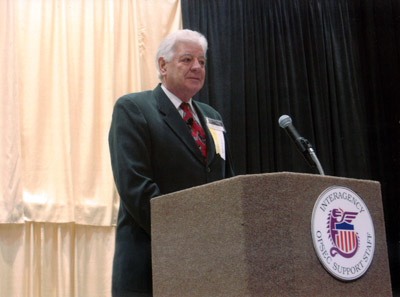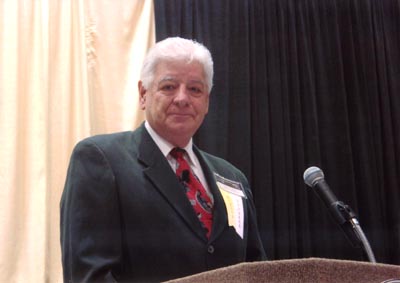|
~ The Social Diary ~ the on-line magazine covering High Society ..& more ____________________________________________________________ Interview
Transcript of William Johnston, Lieutenant Commander, U.S. Navy
(Retired) May 31st, 2006 Interviewer:
Margo Schwab OPSEC
Photos: © Photographs Copyright William Johnston 2006. All
rights reserved. *Mr. Johnston is the father of Scott Johnston, a multi-awarded member of the Police Department, City of San Diego, California. Interview, Part I Begins: SCHWAB: Today, our guest is William Johnston, Lieutenant Commander, U.S. Navy (Retired.) Commander Johnston, thanks for taking the time to be with us. JOHNSTON: It's my pleasure to be here. SCHWAB: Please tell us a little of your background. JOHNSTON: Sure. I enlisted in the U.S. Navy, oh, it seems maybe a hundred years ago, and served almost six years in enlisted status, mostly as a Communications Technician. Under a special officer acquisition program, I was selected for and received a commission as an Officer of the Line. I spent the next sixteen or so years in various positions both at sea and ashore. My duties at sea were in Destroyers and in Amphibious Warfare ships. As to the latter type, I served a tour as Commanding Officer, U.S.S. POLK COUNTY, a Tank Landing Ship, home ported here in San Diego. Ashore, I served in various Intelligence positions, most notably with the Defense Intelligence Agency and with the Commander-in-Chief of the U.S. Pacific Command. Also, I served a tour as the Director of Training at the Pacific Fleet Training Center, here in San Diego. After I retired from the Navy, I became involved in various civilian pursuits. SCHWAB: That's quite an interesting background. Now, turning to current affairs, I understand that you just returned from a week-long trip to Dallas, Texas. JOHNSTON: Yes, I did. I got back to San Diego on Friday night. SCHWAB: What was the purpose of your trip? JOHNSTON: Well, I went to Dallas to participate, as a featured speaker, in the 17th Annual National OPSEC Conference. The conference was sponsored by the Interagency OPSEC Support Staff -that's under the Director, National Security Agency- in association with the OPSEC Professionals Society, the Department of Homeland Security, and the Department of Defense. I also participated as an attendee. SCHWAB: And, what happens at an OPSEC conference? JOHNSTON: An OPSEC conference, like most conferences, is designed to provide training and networking opportunities for professionals. In this case, the professionals are those in management, security, intelligence, infrastructure protection, counterintelligence, military operations, public safety, and related fields. SCHWAB: Who is eligible to attend an OPSEC conference? JOHNSTON: Those eligible to attend an OPSEC conference include all U.S. Government personnel, U.S. Government contractors, State and Local Government employees, and Contractors with a Homeland Security mission. SCHWAB: Who are the speakers at an OPSEC conference? JOHNSTON: The speakers are all recognized experts in their topic areas, and are recruited from both government organizations and private industry. SCHWAB: What subjects were covered in the conference? JOHNSTON: The subjects are covered in a series of briefings set up in the form of tracks. The tracks included: Homeland Security and Public Safety, Threat, Military Operations, Corporate Operations, and General OPSEC topics. SCHWAB: What was your speech about? JOHNSTON: The title of my speech was: The Birth of the Purple Dragon Redux. In the first place, it was a retrospective of the origins, during the Vietnam War, of the OPSEC function and of the impacts of its implementations by members of the Staff, Commander-in-Chief, U.S. Pacific Command, under the command of Admirals Ulysses S. Grant Sharp and Admiral John S. McCain, Jr., respectively. In the second place, I did some comparing and contrasting of the Vietnam War with the Global War on Terror. SCHWAB: You've used the acronym "OPSEC" several times now. What, specifically, does OPSEC stand for? JOHNSTON: Oh, sorry. OPSEC stands for Operations Security. SCHWAB: OK. And, what, specifically, is Operations Security? JOHNSTON: Well, although that's a short question, it may require a somewhat long answer. The short answer is: essentially, Operations Security is the name of a methodology used in a risk management program. It's a five-step program that actually has more to do with Operations than with Security, per se, although it deals with Security Disciplines, such as Physical Security, Communications Security, Information Security, and the like. You see, intelligence collection -collecting the dots- and analysis -connecting the dots- is a lot like putting together a picture puzzle. Intelligence collectors know how important it is to obtain small bits of information, or "pieces" of a puzzle, from many sources and assemble them into the overall picture. SCHWAB: How do these intelligence collectors obtain these bits of information? JOHNSTON: They use lots of different sources and methods. SCHWAB: What kind of sources can you tell us about? JOHNSTON: Oh, there are many sources. The information I am talking about might be collected by monitoring radio and telephone conversations, analyzing telephone directories, financial or purchasing documents, position or "job" announcements, travel documents, blueprints or drawings, distribution lists, shipping and receiving documents, even personal information or items found in the trash. The goal of OPSEC, as a countermeasures program, is to deny to an adversary those pieces of the intelligence puzzle. SCHWAB: How would they gain access to these kinds of information? JOHNSTON: Some are difficult, but some can be quite easy. The methods range from sophisticated surveillance using highly technical electronic methods to just simple visual observation of activities that we call "indicators." And, of course, there is the spy. The premise of OPSEC is that the accumulation of one or more elements of unclassified but sensitive information or data could damage national security by revealing classified information through logical linkages to the indicators. SCHWAB: That's kind of confusing to a layman. JOHNSTON: Yes, I'm afraid it is. Let me try to explain. SCHWAB: Please do. JOHNSTON: The OPSEC process has to be tailored to the specific organization and activity being analyzed. Also, the process is a cycle where, after countermeasures are implemented, you have to continue to evaluate the situation. SCHWAB: Can you tell us what the five steps are? JOHNSTON: Sure. Fundamental to the OPSEC process is determining what information, if it becomes known to one or more adversaries, would harm an organization's ability to carry out an operation or activity effectively. So the first of the five steps in the OPSEC process is to identify the critical information to be protected. SCHWAB: OK. Once you know what you want to protect, what do you do next? JOHNSTON:
The second step is to analyze the threat. This means you need
to know who the adversaries might be. You also have to know what
information they need to meet their objectives, and whether they
have both the ability and the intent to collect, process, analyze,
and use that information. To complicate things, in a given situation,
there may be more than one adversary and each may be interested
in different types of information. JOHNSTON: The third step is to analyze your own organization's vulnerabilities. To do that, you have to know how your operation or activity is actually conducted by the members of the organization, rather than how "the book" says they should do it. SCHWAB: How do you do that? JOHNSTON: The best way is to look at the organization or activity the way the adversaries would. Literally, you do what we call, "Looking through the eyes of the adversary." This way is the key to discovering indicators that could allow an adversary to deduce your intentions to a relatively high degree of accuracy. SCHWAB: So, you first decide what you want to protect, then you figure out whether your adversary wants to and is able to gather the information, then you look at what you are doing to see if you are, in a sense, broadcasting indicators that the adversary can use to figure out what you plan to do. JOHNSTON: Exactly. Very good call. But we aren't finished yet. We need to take the fourth step and assess the risk. After all, we don't have unlimited time or money. At some point, depending on where we are in the operation, we might not even care what the adversary might find out because it will be too late for him to do anything about it. SCHWAB: So, you're saying that there is also a time-value to the information? JOHNSTON: Right again. So now we move to the fourth step, assessing the risk. To assess risk, we have to match specific vulnerabilities with specific threats. Where we find the vulnerabilities are great and the threat from the adversary threat is also great, it is evident that the risk of adversary exploitation is high. In this case, we would set a high priority for protection, and would take countermeasures to deny the adversary the information. On the other hand, where the vulnerability is slight and the adversary has, say, a marginal collection capability, we can set a lower priority. SCHWAB: So, logically, you would then want to match the countermeasures to the risk, right? JOHNSTON: You have nailed it again. That's exactly right. So step five in the OPSEC process is applying countermeasures designed to eliminate or drastically reduce the vulnerabilities, the threats, or the utility value of any indicators to the adversaries. Obviously, different countermeasures likely to work in a particular situation may vary in their effectiveness, feasibility, and cost. The decision as to whether to implement a particular countermeasure is based on a cost/benefit analysis with respect to the overall program objectives. SCHWAB: That all sounds very time consuming and complicated. JOHNSTON: In some respects, it is. But, I'll bet you practice OPSEC at home without knowing that's what it is called. I'll give you an example. Say you've read in your paper that there has been a string of burglaries not too far from your neighborhood. People have come home from their vacation to find their house ransacked. Let's say that you're going away on vacation for a week or so and you want to lessen the risk that your home will be hit by a burglar. What do you do? One good countermeasure is to call the newspaper and cancel deliveries while you are away. You do this because if you let newspapers pile up in front of your house, that's an indicator to a burglar that nobody's home. You probably do this with another indicator, your mail, too; or maybe you have a neighbor collect and keep them for you till you get home. You might also leave a vehicle parked in your driveway. You might connect your porch lights and inside lights to a timer so they will go on and off at preset times to make it look like someone is home. Likewise, you might put a radio on a timer so that it comes on and goes off at various times of day to make it sound like someone is inside. Well, guess what? You practiced OPSEC! SCHWAB: Yes, I've done all of those things. JOHNSTON: Let's analyze the situation in OPSEC terms. Since burglars definitely do not like high-risk situations, like a confrontation on the job, in this case, the critical information is obvious: it is whether anyone is home or not. You don't want anyone to know your house is unoccupied, so that is the information you want to protect. You protect it by removing any indicators that a burglar could use to deduce that you are not at home. Yet, none of the countermeasures, or actions you took, directly concealed the fact that your home was not occupied. A newspaper on the lawn or driveway doesn't necessarily mean no one is at home. Newspapers in the yard or driveway are only one indicator to a burglar. That indicator, though, combined with other indicators such as no internal lights at night, mail stuffed in the mailbox, and so forth, can provide the burglar with the information he needs to reach a conclusion with an acceptable level of confidence. In this case, the more indicators the burglar is able to spot, the greater the level of confidence he will have in his conclusion that people are away. When you eliminate the indicators, though, a burglar will not have this kind of confidence and you will have a much better chance of not having your home burglarized while you are away. SCHWAB: Oh, I see what you mean. That's a lot more clear. So, how did OPSEC originate? JOHNSTON: For that, I'll need to go way back into history. SCHWAB: OK. Go ahead. JOHNSTON: The genesis of Operations Security, as a discipline, occurred in The Vietnam War Era. Because our intelligence services revealed that the Viet Cong and North Vietnamese Army were somehow obtaining foreknowledge of many of our operations, a group of officers and men, seventeen individuals, to be exact, were pulled together to set up a Top Secret organization within the headquarters of the Commander-in-Chief of the U.S. Pacific Command. Our mission was not only to determine how the enemy was obtaining foreknowledge, but to come up with countermeasures to stop them from continuing to obtain foreknowledge. The Unclassified Nickname given to our organization was, "Purple Dragon." SCHWAB: So what did you do? JOHNSTON: Well, since no such organization had existed before, we were freed by our commander, Admiral U.S. Grant Sharp, U.S. Navy, to use our own initiative and imagination. At first, operating by SOP, that's "Seat of the Pants," we went out to discover foreknowledge problems. Once we found a problem, we designed and developed countermeasure programs, methods, and procedures intended to prevent enemy exploitation of our activities. SCHWAB: So how did you go about discovering problems of foreknowledge? JOHNSTON: We did this by putting together, out of our seventeen people, joint-service, interdisciplinary teams that accompanied ground, sea, riverine, and airborne units of all U.S. Armed Forces on regular and special forces combat operations. We called what we were doing "taking surveys." We traveled . . . did we ever travel, not only throughout the Vietnam combat zones, but elsewhere in Southeast Asia and the Far East. We would conduct on-site observations, collect data, and analyze operational, administrative, and logistic support activities to determine possible sources of enemy prior-awareness of friendly intentions. SCHWAB: So, how did this work out? JOHNSTON: I am proud to say that we exceeded even our own expectations. Our efforts resulted in preventing enemy exploitation of a wide range of our operations and significantly raising combat effectiveness. The ultimate result was the saving of human lives and material resources of an incalculable magnitude. And, lest you think I am claiming undue credit for myself, let me emphasize that the key to our successes at CINCPAC was our attention to basics and our tightly integrated teamwork. Without that attention and tight integration of effort, those successes would not have been possible. Picture this: seventeen people from different armed services, different disciplines, different ranks, all working in the same space, striving together to make sense out of mountains of information; collecting it, studying it, analyzing it, vetting it within the staff, deciding what to do with it. SCHWAB: So what eventually happened? JOHNSTON: I am again proud to say that our highly effective methodology became the model applied to U. S. military and naval operations worldwide. Later, we assisted in developing conference goals and agenda items for the first worldwide OPSEC conference. Also, the Chairman of the Joint Chiefs of Staff of the Armed Forces directed us to prepare a draft OPSEC Survey Guide for worldwide use. Our methodology was adopted by the federal government in 1988 as mandated by National Security Decision Directive Number 298 issued by President Ronald Reagan. The Operations Security professionals of today learned our methodology and are using those proven programs, methods, and procedures as we speak. SCHWAB: That sounds exciting. Is it possible for you to give us some details about some of the operations you were involved in? JOHNSTON: Yes it is, with a caveat. Since the OPSEC activities in which I participated were heavily associated with very highly-classified and tightly-compartmented special intelligence and other such code-word materials, obviously, it was not possible for me to keep "mementos" of any kind. So, where I talk of the past, where I could not find officially declassified information, I dredged things up from my long-term memory. Even though I think I still have a keen memory, the mists of time do tend to accumulate and sometimes details can become obscured. Having said that, I assure you that I am confident that I can differentiate between those subjects I can discuss and those on which I must continue to maintain complete silence. What that means is that I can tell you some details, but not all of them. Is that OK? SCHWAB: Yes, of course. JOHNSTON: I participated in a number of "surveys" where we were very successful in producing analyses that successfully pinpointed sources and determined the degree to which many activities in the Pacific Theater of Operations were being exploited by hostile foreign intelligence interests. But, the first operation I became involved in was Operation ARC LIGHT, the U.S. Air Force, Strategic Air Command, B-52 Bombing Operations in North and South Vietnam, Laos, and Cambodia. Operation ARC LIGHT began on June 18, 1965 when 30 B-52's, 10 cells of three aircraft, each with six aircrew aboard, thundered down the runway at Andersen Air Force Base, Guam, en route the 1 by 3 kilometer target boxes at Ben Cat, about 40 miles north of Saigon containing concentrations of Viet Cong and possibly as high as 6000 North Vietnamese Regular Army troops. To ensure the 12-hour mission remained a secret, the planners of the operation intended that it be carried out in complete radio silence from beginning to end, including prestrike aerial refueling from KC-135 tankers that would take off from Kadena Air Base, Okinawa about one-and-a-half hours after the bombers had departed Guam. The refueling was to take place on five parallel tracks in an area chosen to avoid commercial airspace. The tracks, all at the same altitude, and separated by 20 nautical miles, were to be entered from a common Initial Point. Twenty miles is a long distance if you are hiking, but traveling at 500 knots you can cover the distance in 144 seconds. Now, refueling requires a precise rendezvous when the tankers and the bombers are not flying in company, so most refueling tracks incorporate a pair of turns called a "timing triangle," to allow navigators a chance to adjust their arrival time. The tracks designated for the first ARC LIGHT mission lacked these triangles. SCHWAB: Did the lack of those triangles pose a problem? JOHNSTON:
Yes, it did, and a serious problem indeed, because it came to
pass that one cell of bombers arrived at the rendezvous point
too early. To take up the slack while awaiting the arrival of
the tankers, they executed some turns off the assigned refueling
track. For some reason, during one of those 360-degree timing
adjustment turns, they crossed into the track of another cell.
Two B-52's slammed into each other. Both aircraft were crippled
and fell into the sea. Eight of the 12 crew members were killed.
The remaining four crewmen parachuted successfully and were rescued
from the sea by USS Point Defiance (LSD-31.) Despite the disastrous beginning, all of the bombs were dropped into the correct target boxes, except for one string which, because of a radar malfunction, completely missed the target. Next day, the press generally derided the raid as an expensive and costly failure. One report claimed that only one water buffalo and 100 pounds of rice were destroyed. One report said that the bombs were dropped on an area that the Viet Cong had just evacuated. Other reports said that the results of the raid were a lot more effective than the press had led people to believe. SCHWAB: Did they ever find out why the aircraft involved in the collision got themselves into that position? JOHNSTON: Yes, Investigators determined that there were multiple causes, actually a combination of factors: poor planning, weather conditions, forbidden radio communications, and an untested air refueling operation. As you can imagine, further raids were postponed while the operation went back to the drawing boards. In July, ARC LIGHT raids resumed, and during the next 30 months, more than 126,000 sorties were flown from the three bases that were involved in the B-52 effort in Southeast Asia, 126,615, to be exact. Raids over Laos were added in December 1965, and raids to North Vietnam added in April 1966. On May 18, 1969, extensive, secret, bombing of suspected Viet Cong sanctuaries in Cambodia began with 60 B-52s taking off from Guam on what seemed to be yet another "ordinary" ARC LIGHT mission. In good OPSEC countermeasures fashion, at the last possible minute, 48 bombers crossed into Cambodia, each dropping twenty-four tons of bombs on the operating area of the headquarters of COSVN, or Central Office for South Vietnam, North Vietnam's headquarters for staging and directing operations into South Vietnam. In 1972, B-52s were involved in LINEBACKER and LINEBACKER II missions over North Vietnam, and that Operation ARC LIGHT ended on August 15, 1973, with all B-52s withdrawn from Southeast Asia shortly thereafter. Notice,
by the way, these aircraft, now fifty years old, were used to
hit targets during Operations Desert Storm, Southern Watch, Desert
Strike, Desert Fox, Allied Force, Enduring Freedom, and Iraqi
Freedom. These fine aircraft are expected to remain in service
at least until the year 2040, perhaps beyond. JOHNSTON: Well, yes. I did. The first time I shipped out to Vietnam was 1965; the last was 1971, and there were many times in between. I went on missions in all four of the Military Corps areas, and of seventeen named campaigns for persons serving in the U.S. Navy, I participated in eleven. SCHWAB: No doubt you received various awards during your years of service. JOHNSTON: Yes. I am authorized to wear the Meritorious Service Medal, Navy Good Conduct Medal, National Defense Service Medal (2 awards), Korean Service Medal, Vietnam Service Medal with eleven campaign stars, United Nations Service Medal, Republic of Viet Nam Gallantry Cross Unit Citation and the Republic of Vietnam Campaign Ribbon. SCHWAB: That's quite an accumulation of awards. And thank you for serving our country. I'm sorry to say, that's all we have time for right now. Commander, I thank you again for being with us here today. It has been quite a revealing and educational interview. I hope you will consider coming back and providing us with more of your experiences and insights, especially with respect to comparing and contrasting the Vietnam War and the Global War on Terror, and the fascinating subject of OPSEC. JOHNSTON: You are quite welcome, and I'd be glad to. Interview Part I Ends
* Margo Schwab has
produced, written, interviewed and photographed for various media
organizations since 1989. Schwab has a college degree
from Scripps College and a Masters of Business
degree from the University of San Diego.
Schwab volunteers for numerous charity organizations. She also
continues to lobby for water safety and for family violence mitigation.
Schwab is the owner and publisher of The Social Diary.
back to New this Week.....Margo Schwab Archives.....Parties...... Home Warning ** photos, video and writing on this site are the copyright of the author, The Social Diary, San Diego Social Diary, margomargo.com and Margo Schwab. no reproduction of any part or parts is allowed without written permission by Margo Schwab
|
||
|
|
_____________
_____________





